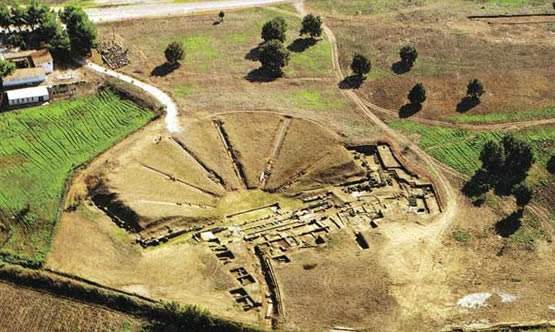
















Ancient olympia history

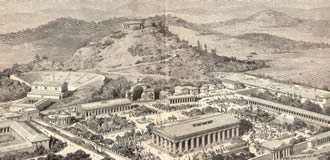
>>
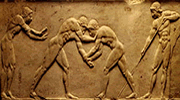
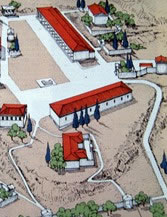
The ancient city- state of Ilida developed in North West Peloponnesus, 40 km from Ancient Olympia and far away from the big city centres of the rest of Greece and it didn’t play an important role to the military and cultural actions that took place. It was in the forefront however, for a long time since it had the custody of the Greek temple of Olympia and the flawless organization of the Olympic Games.
The findings so far have shown that the Ilida area was populated, even as a small agricultural perish, from the Proto- Hellenic era (almost 2800-2000 B.C.). During the Mycenaean period about (1600-1100 B.C.) it was one of the four most important attractions of the area. Its residents are referred in Ilida as Epoioi, who took part in the Troic war, with Polixeno as their leader.
The city of Ilida was established, when Oxilos, who had come from Aitolia in the 12th cent. B.C., united all the separate perishes. This is proven by the various findings of sub- Mycenaean, proto-geometrical and geometrical times (1100-700 B.C.).
Oxilos founded the Olympic Games when he embodied the Holly Temple of Olympia in the city-state of Ilida. The games were reorganized in the 8th century B.C. by the descendant of king Ifitos, who signed a treaty with king Likourgos of Sparti and Kleistheni of Pissa.
With this ‘holy treaty’ the whole area was considered sacred, thus securing peace and the success of the games. Since 776 B.C. the year when the first Olympic Games were held, the residents of Ilia were responsible for the protection of the Temple, which they lost in 668 B.C. and gained it back with the assistance of the Spartans in 580 B.C.
From that point on to the end of the 5th century the city flourished. The main target of the state was not the political, but the cultural and other matters of the public and mostly the organization of the Olympic Games. The games were organized every five years most possibly in July. The athletes, according to the rules had to come to Ilida one month before the games for workout. Friends and relatives came with them and as a result exceptional foreigners from the main Greece and the islands, as well as rich immigrants of Micra Asia, Pontos, Great Greece and Africa.
Ilioi gave great attention to the organization of the games, which is obvious by the picture of the city’s market. The traveler Pausanias (2nd century P.C.), refered to the capital of Ilia, by describing gymnasiums, lodges, temples and sanctums, but no public buildings.They were decorated by a number of statues and sculptures made by famous artists of ancient times. Among others there were situated the temple of Ourania Aphrodite and its golden ivory statue made by Fidias, as well as the ground shrine of Pandimou Aphrodite, where there is its well-known bronze statue, made by Scopas, the temple and the statue of Apollo Acesious, the temple of the Graces, with their edge-stones statues, the temple of Silinous and the complexion of the god with Methi.
During the period of its great rise, the state of Ilia consisted of four regions: the Valley Ilida, the productive area where the capital of Ilia developed, the Acroreia, the Pisatida and the Trifilia. Its residents lived in peace, well-being and well-ruled.
The productive ground of the area and the favourable climate facilitated the development of agriculture and cattle-farming. What is more the name of the people and the area Ilida and Ilioi (in ancient times F-alis and F-alioi) meant valley.
During the recent years 120 perishes have come to light, and the regional surveys have revealed 200 more positions. Most of them must have been small villages or isolated agricultural areas. Only the capital Ilida developed into a major city centre. Especially after the establishment of democracy and the second habilitation (471 B.C.), the city was significantly reinforced and became one of the most important and most populated cities of Peloponnesus. It involved the area, where the today’s villages Paliopoli in South-East, Bouhioti in South –West and Kalivia in West are situated. The ancient acropolis was situated in the Agiannis Hill.
In the late roman and first Christian years (3rd-5th century B.C.) the habilitation was restricted in only one part of the city, while in other parts a big cemetery was created, probably after the destruction of the Eroulous (267 P.C.).
The deterioration started when the Byzantine emperor Theodosius the first, banned the organization of the Olympic games in 393 P.C. and the life of the holly temple of Olympia came to an end. The earthquake that destroyed the country in the 6th century P.C. meant the end of the Ilia’s state.
In the 19th century travellers spotted the city of Ilida and made a map of the area. The first organized excavations were made by the Austrian Archaeological Institution from 1911-1914, under the management of Otto Walter. From 1960 to today the excavation research has been continued from time to time by the Archaeological Company. A part of the ancient city was revealed (1965-1970) by the revenue office of pre-historic and classical archaeologies during the works for the irrigation system of the Peneus Dam.
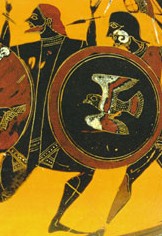
Description
The extensive archaeological site of ancient Elis comprises the ancient agora, the theatre, the residential sector, the cemeteries, the acropolis, and the unexcavated gymnasiums. A number of settlements or suburbs, each with its own cemetery, developed around the city. Only small sections of the city have been investigated so far, but these provide enough information to help us imagine how the city looked.
The agora remained largely unchanged until the very end, with some minor remodelling in the Roman period. Other early buildings, however, were replaced by new constructions particularly in the Late Hellenistic and Roman periods. Both the early buildings, which were built of ashlar blocks in the ancient Greek manner, and the later ones were systematically looted for building material in Late Antiquity and later periods.
The theatre, a striking monument with a characteristic earthen cavea and a well-preserved stage building, occupied the north end of the agora. It enjoyed views of the river, which, in antiquity, ran very close by, along the city's north limits. A bridge crossed the river near that point and a strong embankment protected the city against floods. The Bouleuterion and the city's two gymnasiums were most probably located near the theatre.
The city's religious and possible administrative centre occupied the agora's south end. Here, various buildings lie haphazardly within a relatively limited space.
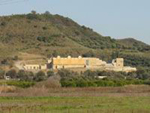
The Archeological Collection of Ilida
was established in 1981.
The findings that were brought to light by the excavations are dated from the Protohellenic to the Roman era. Tools, statues, sculptures, tombs, clay and stone architectural parts, idols, bronze objects, weapons, coins and other small objects.
The bronze “ticket” theatres are of particular interest, which had “FA” (LEION) written on and were found in a big number and are dated to the end of the 4th century B.C. The clay masks and the women icons are exceptional species of sun ton plastic.
Two species of mosaic floor that are displayed in the aula of the Archaeological Collection are highly appreciated. They come from a huge mansion of the 3rd century P.C. built in the south-west of the Ilida market. They have circular representations that are connected to the nine Muses while the other refers to the labours of Hercules.
